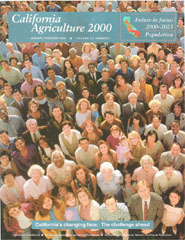All Issues

California's changing face: The challenge ahead
Cover:
Californian's are becoming more numerous, urbanized, and diverse. The future will also see rising proportions of aging baby boomers and ethnic youth. Photo by Ken Fisher/ Tony Stone Images.
January-February 2000
Volume 54, Number 1
Volume 54, Number 1
News and opinion
Women, minority farmers are growing in California
Women, minority farmers Grandparents become parents Tidal Wave It





